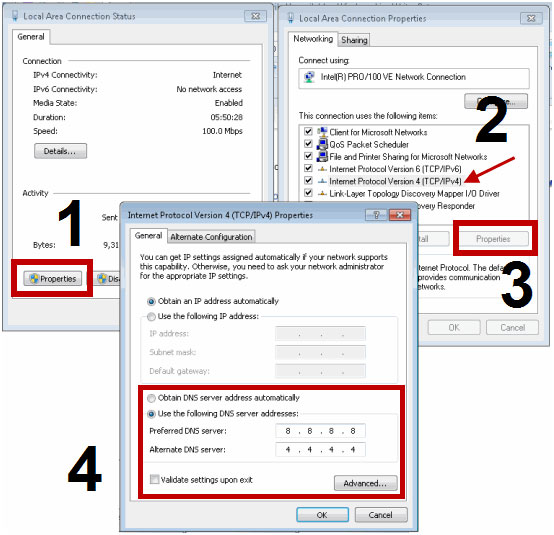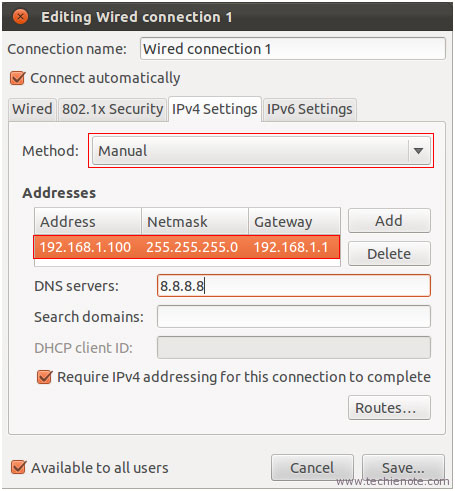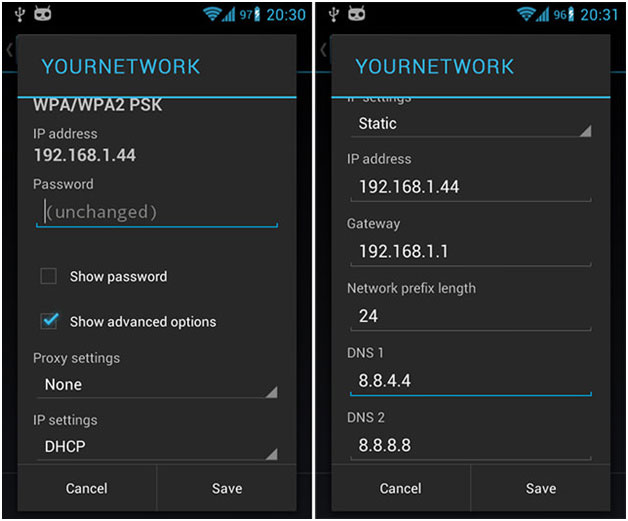Windows
DNS settings are specified in the TCP/IP Properties window for the selected network connection.
Example: Changing DNS server settings on Windows 7
1. Go to the Control Panel.
2. Click Network and Internet>Network and Sharing Center>Change adapter settings.
3. Select the connection for which you want to configure Google Public DNS. For example:
. To change the settings for an Ethernet connection, right-click Local Area Connection>Properties.
. To change the settings for a wireless connection, right-click Wireless Network Connection>Properties.
If you are prompted for an administrator password or confirmation, type the password or provide confirmation.
4. Select the Networking tab. Under This connection uses the following items, select Internet Protocol Version 4 (TCP/IPv4) or Internet Protocol Version 6 (TCP/IPv6) and then click Properties.
5. Click Advanced and select the DNS tab. If there are any DNS server IP addresses listed there, write them down for future reference, and remove them from this window.
6. Click OK.
7. Select Use the following DNS server addresses. If there are any IP addresses listed in the Preferred DNS server or Alternate DNS server, write them down for future reference.
8. Replace those addresses with the IP addresses of the Google DNS servers:
. For IPv4: 8.8.8.8 and/or 8.8.4.4.
. For IPv6: 2001:4860:4860::8888 and/or 2001:4860:4860::8844.
9. Restart the connection you selected in step 3.

Mac OS
DNS settings are specified in the Network window.
Example: Changing DNS server settings on Mac OS 10.5
1. Click Apple>System Preferences>Network.
2. If the lock icon in the lower left-hand corner of the window is locked, click the icon to make changes, and when prompted to authenticate, enter your password.
3. Select the connection for which you want to configure Google Public DNS. For example:
. To change the settings for an Ethernet connection, select Built-In Ethernet, and click Advanced.
. To change the settings for a wireless connection, select Airport, and click Advanced.
4. Select the DNS tab.
5. Click + to replace any listed addresses with, or add, the Google IP addresses at the top of the list:
. For IPv4: 8.8.8.8 and/or 8.8.4.4.
. For IPv6: 2001:4860:4860::8888 and/or 2001:4860:4860::8844.
6. Click Apply>OK.

Linux
In most modern Linux distributions, DNS settings are configured through Network Manager.
Example: Changing DNS server settings on Ubuntu
1. Click System>Preferences>Network Connections.
. To change the settings for an Ethernet connection, select the Wired tab, then select your network interface in the list. It is usually called eth0.
. To change the settings for a wireless connection, select the Wireless tab, then select the appropriate wireless network.
3. Click Edit, and in the window that appears, select the IPv4 Settings or IPv6 Settings tab.
4. If the selected method is Automatic (DHCP), open the dropdown and select Automatic (DHCP) addresses only instead. If the method is set to something else, do not change it.
5. In the DNS servers field, enter the Google Public DNS IP addresses, separated by a comma:
. For IPv4: 8.8.8.8 and/or 8.8.4.4.
. For IPv6: 2001:4860:4860::8888 and/or 2001:4860:4860::8844.
6. Click Apply to save the change. If you are prompted for a password or confirmation, type the password or provide confirmation.
If your distribution doesn't use Network Manager, your DNS settings are specified in /etc/resolv.conf.

Example: Changing DNS server settings on a Debian server
1. Edit /etc/resolv.conf:
sudo vi /etc/resolv.conf
2. If any nameserver lines appear, write down the IP addresses for future reference.
3. Replace the nameserver lines with, or add, the following lines:
For IPv4:
nameserver 8.8.8.8
nameserver 8.8.4.4
For IPv6:
nameserver 2001:4860:4860::8888
nameserver 2001:4860:4860::8844
4. Save and exit.
5. Restart any Internet clients you are using.
Additionally, if you are using DHCP client software that overwrites the settings in /etc/resolv.conf, you will need to set up the client accordingly by editing the client's configuration file.
Example: Configuring DHCP client sofware on a Debian server
1. Back up /etc/resolv.conf:
sudo cp /etc/resolv.conf /etc/resolv.conf.auto
2. Edit /etc/dhcp3/dhclient.conf:
sudo vi /etc/dhcp3/dhclient.conf
3. If there is a line containing domain-name-servers, write down the IP addresses for future reference.
4. Replace that line with, or add, the following line:
For IPv4:
prepend domain-name-servers 8.8.8.8, 8.8.4.4;
For IPv6:
prepend domain-name-servers 2001:4860:4860::8888, 2001:4860:4860::8844;
5. Save and exit.
Routers
Every router uses a different user interface for configuring DNS server settings; we provide only a generic procedure below. For more information, please consult your router documentation.
Note: Some ISPs hard-code their DNS servers into the equipment they provide; if you are using such a device, you will not be able to configure it to use Google Public DNS. Instead, you can configure each of the computers connected to the router, as described above.
To change your settings on a router:
1. In your browser, enter the IP address to access the router's administration console.
2. When prompted, enter the password to access network settings.
3. Find the screen in which DNS server settings are specified.
4. If there are IP addresses specified in the fields for the primary and seconday DNS servers, write them down for future reference.
5. Replace those addresses with the Google IP addresses:
. For IPv4: 8.8.8.8 and/or 8.8.4.4.
. For IPv6: 2001:4860:4860::8888 and/or 2001:4860:4860::8844.
6. Save and exit.
7. Restart your browser.
Mobile or other devices
DNS servers are typically specified under advanced wi-fi settings. However, as every mobile device uses a different user interface for configuring DNS server settings, we provide only a generic procedure below. For more information, please consult your mobile provider's documentation.
To change your settings on a mobile device:
1. Go to the screen in which wi-fi settings are specified.
2. Find the screen in which DNS server settings are specified.
3. If there are IP addresses specified in the fields for the primary and seconday DNS servers, write them down for future reference.
4. Replace those addresses with the Google IP addresses:
. For IPv4: 8.8.8.8 and/or 8.8.4.4.
. For IPv6: 2001:4860:4860::8888 and/or 2001:4860:4860::8844.
5. Save and exit.

How to Change DNS Settings on Android

How to Change DNS Settings on Apple Device
Test your new settings
To test that the Google DNS resolver is working:
1. From your browser, type in a hostname (such as http://www.google.com/). If it resolves correctly, bookmark the page, and try accessing the page from the bookmark. If both of these tests work, everything is working correctly. If not, go to step 2.
2. From your browser, type in a fixed IP address. You can use http://18.62.0.96/ (which points to the website http://www.eecs.mit.edu/) as the URL.1 If this works correctly, bookmark the page, and try accessing the page from the bookmark. If these tests work (but step 1 fails), then there is a problem with your DNS configuration; check the steps above to make sure you have configured everything correctly. If these tests do not work, go to step 3.
3. Roll back the DNS changes you made and run the tests again. If the tests still do not work, then there is a problem with your network settings; contact your ISP or network administrator for assistance.

